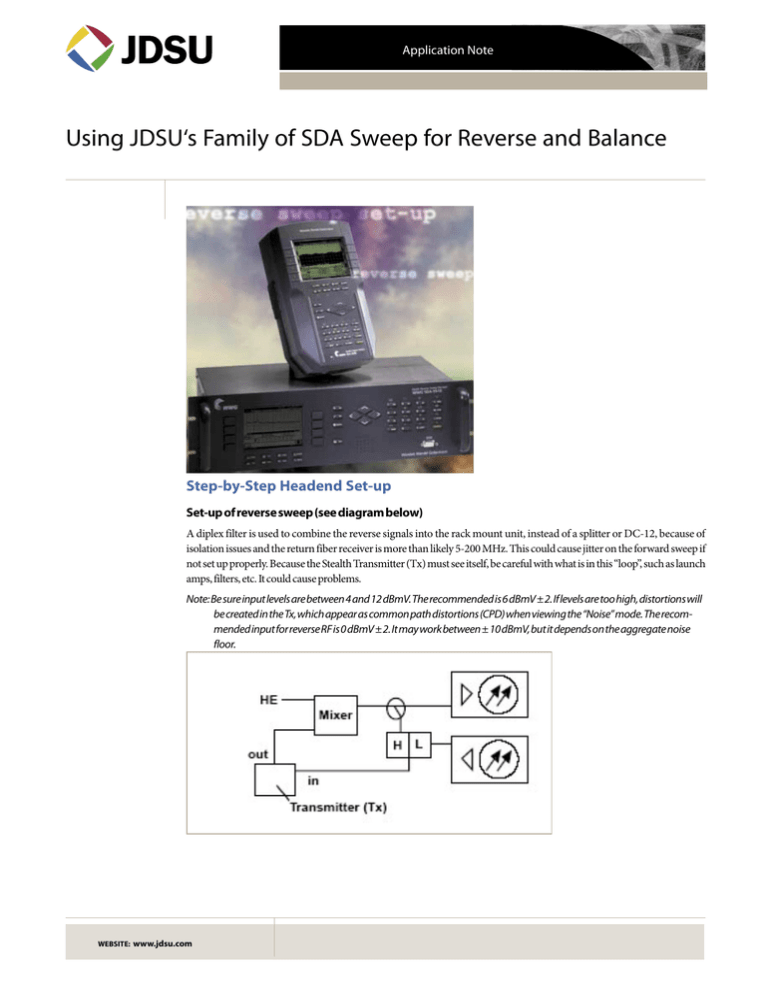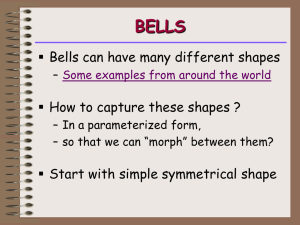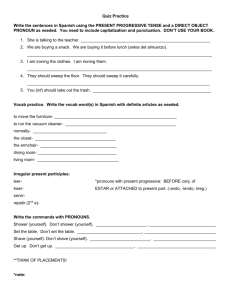
Application Note
Using JDSU‘s Family of SDA Sweep for Reverse and Balance
Step-by-Step Headend Set-up
Set-up of reverse sweep (see diagram below)
A diplex filter is used to combine the reverse signals into the rack mount unit, instead of a splitter or DC-12, because of
isolation issues and the return fiber receiver is more than likely 5-200 MHz. This could cause jitter on the forward sweep if
not set up properly. Because the Stealth Transmitter (Tx) must see itself, be careful with what is in this “loop”, such as launch
amps, filters, etc. It could cause problems.
Note: Be sure input levels are between 4 and 12 dBmV. The recommended is 6 dBmV ± 2. If levels are too high, distortions will
be created in the Tx, which appear as common path distortions (CPD) when viewing the “Noise” mode. The recommended input for reverse RF is 0 dBmV ± 2. It may work between ± 10 dBmV, but it depends on the aggregate noise
floor.
WEBSITE: www.jdsu.com
Application Note: Using the SDA Reverse Sweep and Balance
2
reverse sweep will be inoperable.
“Enable live headend ingress view” allows reverse noise to
be transmitted on the forward telemetry. If disabled, the
forward sweep will be faster.
The Tip Box
When making labels, the
up and down diamond
keys can be used to
access special symbols
(i.e., “@”, “$”, etc.).
“Reverse telemetry frequency” is set-up on the Tx or Rx and
not on the field unit.
Build channel plan (configure; channel plan)
Note: The newest stealth field meter replaced many of
the menus with icons. The “set-up” button has been
replaced with a “configure” mode, which can be
accessed through the “navigator” mode, or by pressing “func” (green key) and the number 3 key. Channel
plans and files names are limited to 15 characters.
Sweep transmitter (configure; sweep transmitter).
“Sweep mode” must be in the appropriate mode to allow
proper operation. The “transmit” mode is the older stealth
sweep, whereas the new “Transmit (SDA compatible)”
mode is for the faster sweep refresh with digital and scrambled carriers present.
The wrong mode selection will create erroneous readings.
“Forward telemetry frequency” must be in the vacant spectrum and at least 500 kHz from any other carrier; it must
also be within the bandwidth of the downstream spectrum.
This is an FSK carrier and approximately 500 kHz wide. The
factory default is 51 MHz on the Tx, 52 MHz on the Rx, and
53 MHz on the PathTrak HSM.
Note: If diplex filters in the actives have a sharp roll-off, it
may be wise to move the telemetry to a frequency
that is more reliable. Make sure that the Tx and Rx
have different telemetry frequencies. The location
and level of the telemetry can cause its second harmonic to interfere with existing channels if not taken
into account.
“Forward telemetry level” determines the level of the
telemetry signal (FSK). This should be set 10 dB below the
video reference level. The telemetry level is adjustable from
20-50 dBmV in 2 dB increments. The max is 50 dBmV,
however some older units may have a max of only 40 dBmV.
“Forward sweep insertion level” is not applicable for reverse
sweeping.
“Include audio carriers” is not applicable for reverse sweeping.
“Enable reverse sweep” allows reverse sweep to operate
in the Tx. If disabled, the forward sweep will be faster but
Note: Be sure to select a reliable frequency void of interference in the most stable part of the passband, not in
the roll off or below 15 MHz.
“Reverse channel plans” are built and/or edited for the
upstream direction. The reverse channel plan must be setup on the Tx. It will automatically be communicated to
the field unit via the forward telemetry. Notice this menu
is found under set-up/sweep transmitter/reverse channel
plans.
Field Unit Settings
On the field unit select (configure; measurements) and
insert all the required information (temperature units, signal level units, fundamental hum frequency, scan rate, etc.).
Note: Select “func” and “7” to enter the Test Point compensation. You can also access the Test Point
compensation through the navigator screen on the
newest unit. There is a toggle button to select forward
or reverse Test Point compensation.
Before you leave the headend
On the receiver select (configure; sweep receiver) and set
the forward sweep telemetry frequency to be the same as the
Tx and/or Rx. Set for the sweep mode intended to be used.
Depending on the options installed in the field unit, these
modes are as follows: “sweepless”, “stealth”, “SDA compatible”, “loopback sweep”, “transmit”, and “transmit (SDA
compatible)”.
Normally we would select “Stealth” or “SDA compatible”.
Also set the reverse sweep insertion and telemetry levels
as close to the system specifications as possible, taking into
consideration insertion losses.
Note: Sweep and telemetry levels >15 dB above the recommended input could cause return laser clipping and
erroneous balancing and sweep traces. This depends
upon the type of laser and return hybrids used.
Put in “single user” mode if using the Tx for reverse sweeping, or in “multiple user” mode if using the Rx. Be sure the
Tx is in the sweep mode and the reverse is enabled.
Application Note: Using the SDA Reverse Sweep and Balance
Reverse balancing and sweeping
The Tip Box
The quickest way to
determine if your field
unit has reverse capability is to verify that there
are two connections on
the top of the field unit.
First, balance the forward path and press “sweep” to verify
all is well, then proceed with reverse.
Check the sweep in both directions. Change the sweep
direction on the receiver to reverse by using the left diamond key or selecting the following sequence: (configure;
sweep receiver; sweep direction).
Note: The NS-6 or DDC-20 is necessary for firmware version
8.5 or earlier. A summation network for return path
sweeping is not necessary for versions 9.x or later.
There must be a place to inject the sweep, which will
make its way to the Tx or Rx.
Record the reverse telemetry level, recommended reverse
input, and test point loss. A reverse sweep reference can also
be taken at this time by selecting the sequence: (“func” and
“6”). A name must be entered for your reference.
Take a normalized reference at the node; at each leg if warranted.
Note: It’s good to compare “apples” to “apples”. Don’t
change things like in-line pads and test leads once a
reference has been stored. Store a new reference otherwise.
If you use the internal, directional test point, it must be an
injection test point. You may be able to sweep in reverse
using the forward test point if it is on the outside of the
diplex filter. Otherwise, bi-directional test points can be
used, but may give misleading displays because of standing
waves. Use a tap if possible. You must use a splitter or diplex
filter when using the same TP for injection and reading.
Note: Be sure to turn off the ALC in the reverse rack mount
receiver if present. Also turn off the ALC in any LAN
return amplifiers. Each ALC sensitivity will have to be
adjusted after balancing is completed.
Note: The “max/min” displays the peak-to-valley between
the markers. The delta displays the difference in level
and frequency at the markers.
Proceed to the first amplifier from the node and reverse
sweep and balance to a flat line using an EQ. Use the corresponding node reference for the leg being balanced.
Use a pad to achieve a telemetry level X dB higher than what
was documented when the reference was stored. X = (A-B)
where A = the recommended reverse input of the active
where the reference was taken + test point loss + accessory
losses + Summation Network loss. B = the recommended
reverse input of the amplifier being balanced + test point
loss + accessory losses + Summation Network loss. Only
losses in the reverse injection path are considered.
3
Note: The recommended injection level is dependent upon
if you are balancing constant inputs to the port or
hybrid, and where the actual injection point is located. Many systems balance constant inputs to the port
and take into account extra accessory losses such as
internal “feeder makers” and input pads if warranted.
The reasoning behind constant inputs to the port vs
hybrid is beyond the scope of this application note.
The reference line on the display should also be X dB. Look
at M1 and M2 on the stealth field unit display to verify. The
“Ref ” on the sweep display is the middle graticul line, not
the actual sweep level.
Note: The sweep trace displayed on the field unit will
change if someone in the headend changes the test
point compensation on the Tx. This also affects the
reverse alignment mode on the field unit.
Others may use test point compensation and change the
injected telemetry level to account for different test points,
different recommended injection levels, and extra accessories. They then balance to a 0 dB reference line and the same
telemetry reading as was achieved at the reference.
Note: The newest unit works a little differently. The reverse
test probe value adds to the telemetry and sweep
values to give the actual output of the field unit. It also
has a reverse alignment mode, which can only be
accessed through the Navigator mode. The markers
give actual received levels in the Headend as if using 2
CW carriers with a “raw” sweep behind it.
Another way
Suppose you have a node with 20 dB test points and a recommended in of 15 dBmV, and a trunk amp with 25 dB TPs
and recommended in of 17 dBmV. The bridger amp with 20
dB TPs has a recommended in of 12 because you are inserting at the hybrid, balancing constant inputs of 17 dBmV
to the port, and the internal loss from the test point to the
hybrid is 5 dB. There is also an LE with a 26 dB tap for injection and a recommended in of 17 dBmV.
After adding all the numbers and the extra loss of 3.5 dB
from the summation network (splitter) used in reverse balancing, the total generator output would be:
Node = 20+15+3.5 = 38.5, Trunk = 25+17+3.5 = 45.5,
Bridger = 20+12+3.5 = 35.5, LE = 26+17+3.5 = 46.5
Find the highest number and set the sweep and telemetry
close to this. For instance, the highest number is 46.5 so they
are set for 46 dBmV.
Store a reference at the node with an 8 dB in-line pad
installed. This will automatically knock down the sweep and
telemetry level without having to change the generator out-
Application Note: Using the SDA Reverse Sweep and Balance
put and the associated problems with doing that (explained
later). Store a reference and record the telemetry.
Go to the trunk amp and install an in-line 1 pad, and reverse
balance to the same reference and telemetry. Go to the
bridger amp and install an 11 dB in-line pad. Balance to the
same telemetry and reference. Go to the LE and disconnect
the in-line pad. Balance back to the same reference of 0 and
telemetry that was recorded when the reference was stored.
The one caveat to this is the inconsistency with in-line pads.
One more variable is added to the equation!
Considerations
There are some things to consider when changing the sweep
and telemetry levels on the field unit for different balancing
scenarios. This may influence your balancing method.
1. Changing the sweep insertion level on the field unit
does not change where the sweep is displayed. The
display you see is gain or loss, not the headend unit
received. If you increase the sweep insertion level on
the field unit, the sweep trace will not increase on the
display.
2. Changing TP compensation changes where the sweep
is displayed on the screen.
3. Changing the telemetry insertion may not have a 1 for
1 effect, and it’s only in 2 dB increments.
4. Do you trust all the technicians to change the level
correctly.
Note: Because this is a sweep, ingress can affect the outcome. It may be advantageous to terminate all
reverse port pads or keep all amplifiers terminated
until activation.
Common Return Sweep Problems
Standing waves
• Use a directional, injection test point if available.
Standing waves could still occur if a mismatch is
close and severe enough.
• Inject into a tap. Some lower value taps may still
give reflections depending on port-to-port isolation
and port-to-output isolation.
• Use a plug-in test point, not a probe. Probes will
always be bi-directional unless they are in series
with the circuit and a directional coupler is used.
• Keep all proceeding actives terminated for return
sweeping. Don’t pre-stuff the reverse pad and EQ.
The noise funneling may hamper your ability to
sweep properly. A high value pad or terminator is
recommended.
4
• Terminate all low value tap ports. Even an
unterminated splitter in a subscriber’s house a few
thousand feet away can cause standing waves. Coax
attenuation at the lower frequencies is slight, which
allows the reflected wave to make it back without
much loss.
• Install a terminating tap (4 port 8 or 8 port 11) if
you have the luxury. It’s an easy way to isolate the
system.
• Verify that test leads, connectors, F-81 barrels, etc.
are good. Use an in-line pad to see if the standing
wave goes away. If so, there is a reflection being
created between the field unit and test point.
Spikes
• Keep the resolution to approximately 1 MHz
for reverse sweep. This lowers the probability
of inadvertent, overlapping sweep points and
transients. A sweep point every 1 MHz is sufficient
in most situations for reverse sweeping. It also
creates a faster sweep update and less memory
required for each stored trace.
• Verify proper set-up, levels, no overlapping sweep
and actual channels, etc.
• Avoid common problem areas (strong off-air
shortwave, ham, and CB at 27 MHz)
No communication
• Check forward sweep to confirm communication
path between the transmitters and field unit.
• Set to “Single User” for Tx return sweeping and
“Multiple User” for Rx.
• It could be collisions with other people reverse
sweeping on the same Tx. Use a Rx if warranted.
• Verify the appropriate telemetry, keep it high
& located in the passband. Watch out for sharp
diplex filter roll-off and old 550 MHz passives in a
750 MHz system. The minimum level for forward
telemetry is approximately -15 dBmV, but can
also overload with greater than approximately
+12 dBmV. We sometimes lose communication on
input test points because of the lack of gain from
the active and the test point loss. Use the spectrum
mode with “max hold” on to verify the existence
of the telemetry and the level. Make sure test point
compensation is 0.
• Check return path continuity. Verify test equipment
connections, amplifier continuity, active gain,
and that no terminators are installed. Look at the
Application Note: Using the SDA Reverse Sweep and Balance
noise floor level on the reverse input and compare
with the reverse output. It should be higher by the
amount of gain of the amplifier, but not necessarily.
The noise reading could be affected by the test
equipment noise floor. It may be warranted to
inject a carrier and read the output to verify
continuity. Use the new “CW Loopback” mode to
verify continuity and gain. Use “Diagnostics” to
send a CW carrier to the headend. Have someone
in the headend use the Tx “Level” mode to read
the reverse carrier level. Be sure to put it back in
“sweep” mode when finished!
• Reverse telemetry must have >20 dB S/N. To
calculate the S/N for the reverse, find the telemetry
level at the headend read on the field unit while
sweeping, activate the “Noise” mode and move
the marker to the same frequency. Record the
difference.
Note: The number of node returns is limited for the Stealth
reverse set-up because the reverse telemetry signal
needs to have > 20 dB S/N. Probably less than 40
nodes should be combined into the headend unit.
This may also influence where you place the telemetry. Stay away from 5-15 MHz because of the inherent
noisy nature of this passband and the upper band
because of diplex filter roll off. Stay away from 27
MHz because of CB ingress and any multiple of 6 MHz
because of common path distortions (CPD).
• Verify the instrument is sweeping in the correct
direction. Press the left diamond key and look in the
upper right corner of the field unit display.
• Press “sweep” on the Tx and make sure reverse is
enabled. (Sometimes it’s the little things that kill.)
• Firmware versions must be the same on the
transmitters and receivers. Older Stealth units with
firmware versions 8.5 and 9.3 are not compatible
and will yield inaccurate sweep measurement
results. Version 9.3 will work with the new SDA
units, but not in the SDA Compatible mode.
Bad response
• Verify accessories are operating correctly such as
cable, push-ons, older summation networks (DDC20), pads, etc.
• Low sweep points may get confused with the noise
floor, especially from the total noise funneling. This
could cause the “grassy” effect on the sweep display.
Increase the sweep insertion level on the field unit
to verify.
5
• Use the correct sweep mode. The wrong mode could
lead to problems.
• High forward levels into the meter can cause severe
intermodulation that can affect the reverse sweep.
Faster reverse sweep
• Make a bogus forward sweep plan on the Tx with
only 1 sweep point. By sweeping the forward faster,
the reverse will also be faster, but forward sweep will
not be usable.
• Use a Rx for up to 10 concurrent sweepers. This
will decrease the probability of collisions with other
sweepers off the same device. It also eliminates the
chance of forward level overload.
Frequency response identification
• Refer to the “forward sweep and balance application
note.”
Other applications
JDSU’s portable stealth receiver with transmitter option can
be utilized to perform the following:
• Segmented sweeping; Moving the transmitter out in
the field to sweep and balance certain spans or legs
of a cable plant.
• Active gain, frequency verification, or single amp
bench alignment; When in the loopback mode,
the portable sweep transmitter/receiver reads its
own signals. One could use it to see the frequency
response and gain of a single amplifier. Set-up a
channel plan with sweep points every 1 MHz for
good resolution. The total number of points is
limited to around 500.
• Segmented “noise” mode for troubleshooting;
Instead of getting the aggregate noise from many
receivers being combined in the headend, one could
use the portable transmitter in the field for better
segmentation of the aggregate noise. You could also
get a PathTrak system for remote analyzing and
performance archiving. Contact JDSU for more
information.
• The “noise” mode
° Refer to the return path troubleshooting
application note.
6
Application Note: Using the SDA Reverse Sweep and Balance
Tips & Hints
1. The field unit is capable of a frequency agile, CW carrier at 50 dBmV (40 dBmV for the older version). Select (Configure; Diagnostics; Transmitter Diagnostics) and set the Tx frequency, attenuation, and turn the Tx on.
Note: You must leave the field unit in this mode for the Tx to stay active. The cable must be attached to the “OPT” port on the
field unit.
2. The field unit is DC blocking to 200 V peak-to-peak. This equates to approximately 100 Vac.
3. Once a trace is stored, you can alter the dB/div, start & stop freq., etc. To print this altered trace, hit “Func” & “Print”.
(Use the printer serial cable supported by JDSU.)
4. The sweep file overlay is a nice feature to view an existing stored file and see the actual sweep trace overlaid. Select
(configure; sweep receiver, sweep file overlay) and turn it on. You can even upload an old file from Stealthware into
the field unit to do an overlay.
5. The de-facto standard is 2 dB/div for sweeping and 5 or 10 dB/div for spectrum analyzer viewing.
6. Select “Func” & “i” for information about the instrument such as calibration date, serial number, options installed.
7. The new SDA unit has added a CW loopback mode that is accessed through the Navigator screen and many other
features. Consult JDSU for a list of these features.
8. The Tx will transmit/broadcast the ingress from all the return amplifiers connected to it back to the field unit. This
will be transmitted on the forward telemetry with 280 kHz of resolution. Return continuity is not needed for this
reception. The noise mode on the Rx transmits the total noise in the headend also, but with a resolution based off
the return channel plan resolution.
9. You can change the start and stop frequencies in the sweep mode of the field unit, which makes it easier to move
your markers around.
10. Type in the frequency and press “enter” to make a marker jump to that frequency.
11. Use “Zoom” to zoom in between the markers.
12. Ten people can reverse sweep at the same time with the Rx. The stealth receiver unit must be set for the correct
telemetry and for “multiple users”.
Note: The Rx must have firmware version 9.3 installed or be a new SDA-5510 to communicate with the SSA-1000 or
SDA-5000. The sweep mode must be the same as well.
13. The Rx not only displays the noise received, but can also be used to determine who is reverse sweeping.
14. The number of sweep points is limited to 500, but inserting too many will make the refresh of the sweep display
slower and take up more memory for storage of files. The sweep update time is dependent on the set-up.
All statements, technical information and recommendations related to the products herein are based upon information believed to be reliable or accurate. However, the accuracy or completeness thereof is not guaranteed, and no
responsibility is assumed for any inaccuracies. The user assumes all risks and liability whatsoever in connection with
the use of a product or its applications. JDSU reserves the right to change at any time without notice the design,
specifications, function, fit or form of its products described herein, including withdrawal at any time of a product
offered for sale herein. JDSU makes no representations that the products herein are free from any intellectual property
claims of others. Please contact JDSU for more information. JDSU and the JDSU logo are trademarks of JDS Uniphase
Corporation. Other trademarks are the property of their respective holders.
© 2006 JDS Uniphase Corporation. All rights reserved. 30137256 500 0906 SDAREVSWEP.AN.CAB.TM.AE
Test & Measurement Regional Sales
NORTH AMERICA
LATIN AMERICA
ASIA PACIFIC
TEL: 1 866 228 3762
FAX: +1 301 353 9216
TEL:+55 11 5503 3800
FAX:+55 11 5505 1598
TEL:+852 2892 0990
FAX:+852 2892 0770
EMEA
TEL:+49 7121 86 2222
FAX:+49 7121 86 1222
WEBSITE: www.jdsu.com



